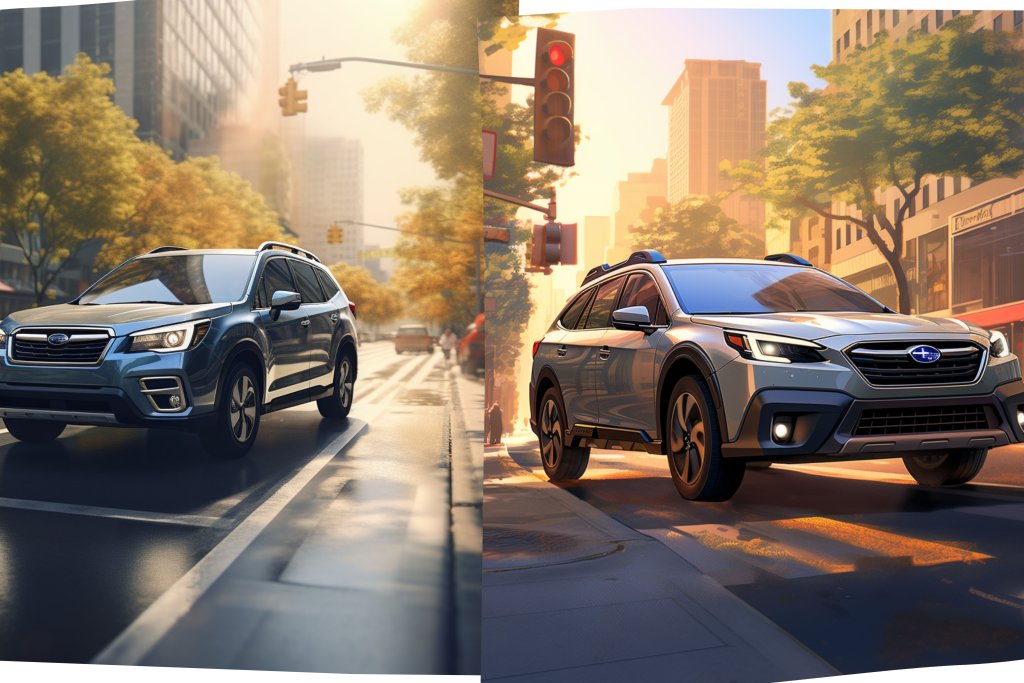Subaru owners have strong connections with their cars. According to a 2021 J.D. Power study, Subaru has the highest loyalty rating (61.8%) among mainstream automakers, beating brands like Toyota and Honda.
So, it’s not unusual that a “Subie” fan might have difficulty deciding between the Forester compact crossover and the larger Outback SUV (yes, you can make a case that the Outback is a wagon). Competing vehicles like the Toyota RAV4, Honda CR-V, and Mazda CX-5 may already be ruled out, but selecting the best Subaru can still be a task ahead.
With this in mind, we’ve compiled a comprehensive guide comparing the Subaru Forester and Subaru Outback. Not only do we examine the 2023 models, but there’s also a deep dive into the reliability, market value, safety, and fuel economy of used Foresters and Outbacks since 2001. In addition, FIXD owner surveys provide insights into these vehicles.
Whether new or used, the Forester and Outback have much in common—no surprise. But a review of facts shows substantial differences. For instance, older Outbacks have a poor history of engine reliability, much worse than many same-year Foresters. This goes hand-in-hand with higher maintenance costs for the larger Subaru.
New car shoppers must also pay attention to the contrasts for the 2023 editions. For instance, the Outback has more cargo space, while the Forester has better front legroom. Along with the distinctions come similarities. Base model buyers may find it interesting that only $2,000 separates the entry-level Forester and Outback.
Keep reading to learn all the details of this Subaru Forester versus Subaru Outback match-up. There are other comparisons to check out, including: RAV4 vs. CR-V, Civic vs. Corolla, Pilot vs. Highlander, and Odyssey vs. Sienna.
| Income Bracket | Monthly Financing Cost Range | Cash Purchase Price Range | Subaru Forester Years | Subaru Outback Years | Best Model Year: | Why? |
| < $5k | $42 – $83 | $1,500- $3,000 | 2004 | N/A | 2004 Forester | Low price |
| $5k – $10k | $83 – $125 | $3,000 – $4,500 | 2009 | N/A | 2009 Forester | Good value, decent engine reliability |
| $10k – $15k | $125 – $187 | $4,500 – $6,750 | 2013 | N/A | 2013 Forester | Strong engine reliability |
| $15k – $25k | $187 – $312 | $6,750 – $11,250 | 2015 | N/A | 2015 Forester | Strong engine reliability |
| $25k – $35k | $312 – $437 | $11,250 – $15,750 | 2016 | 2014 | 2016 Forester | Excellent engine reliability, solid value |
| $35k – $50k | $437 – $625 | $15,750 – $22,500 | 2020 | 2019 | 2019 Outback | Excellent engine reliability, solid value |
| $50k – $74k | $625 – $925 | $22,500 – $33,300 | 2021 | 2021 | 2021 Outback | Excellent engine reliability, solid value |
See the methodology for the table above.
Before you respond to the “For Sale” ad, check out this How to Buy a Used Car article for a step-by-step checklist.
Price History Comparison | Subaru Forester vs. Subaru Outback
Average Market Value – Based on Owners’ Self-Reported Mileages | Subaru Forester vs. Subaru Outback
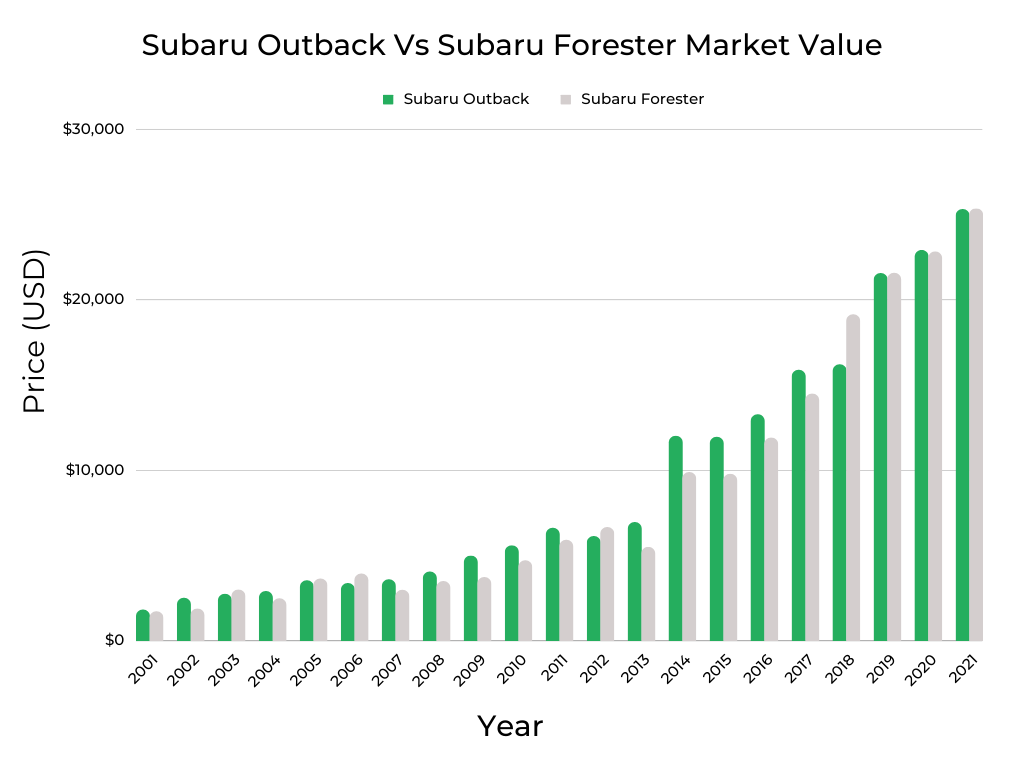
Price is a major influencing factor for most car buyers. We’ve compiled 21st-century sales data from Kelley Blue Book (KBB) for the Forester and Outback. For the most part, this pair of Subarus have similar market values for each of the model years. These details reflect privacy-party transactions, which are about a third to half as expensive as dealer pricing. Shopping for an older vehicle or one with more miles (or less equipment) can reduce retail pricing.
Mileage is also baked into these Forester and Outback numbers. A car with fewer miles will cost more than the same vehicle with greater mileage. And model year affects the price. The newer the car, the higher the price—that’s also what’s shown in the chart. The value of the Outback (green) and Forester (gray) increases with each newer model year.
A look at the 2014 to 2018 model years highlights a more significant difference in market value between the Forester and Outback. This can be explained in two ways. First, the Outback usually costs more than the Forester when new. So it’s worth more. And FIXD surveys show (for whatever reason) that the analyzed Outbacks have fewer miles than their model-year Forester counterparts.
Curiously, the results are flipped for 2018, with the Forester worth more. However, the FIXD surveys report these Foresters have about one-third less mileage, explaining the difference.
This see-saw in values is unusual. Typically, our car versus car comparisons reveal that one model usually does a better job of holding its value over its challenger. That’s not the case with this Forester versus Outback match-up. So, s7hoppers must be more thorough in their research and not assume that the Forester or Outback is a better buy.
Be sure to read our Best and Worst Years series of articles highlighting the Subaru Forester and Subaru Outback winners and losers.
Depreciation vs. Maintenance Expenses
While new cars are bright and shiny, depreciation quickly dulls the luster. During the first year, the value of a new automobile can plummet by 10%–15%. Over five years, depreciation can rise to half the car’s original sticker price. As such, value-conscious car buyers try to avoid ongoing devaluation like the plague. This means looking at vehicles that are at least ten years old—after a decade, depreciation tends to settle down.
But there’s more to smart car shopping than searching for an older vehicle. Considering repair cost history is another crucial step. For the Forester, a good blend of depreciation and upkeep occurs with the 2002-2011 model years. Yet, this sweet spot window (the black-outlined box) is much smaller for the Outback. Only the 2005-2008 model years are ideal.
Later, we’ll examine repair and maintenance costs for both vehicles, which may explain why fewer bang-for-your-buck Outback choices exist.
But don’t assume every example within these ranges is a smart buy. Learn more by reviewing the best and worst years of the Subaru Forester and Subaru Outback. There’s also an at–a–glance summary towards the end of this article.
Reliability Comparison | Subaru Forester vs. Subaru Outback
Two ratings are at the core of our look at the Subaru Forester and Subaru Outback.
- The FIXD Reliability Score measures the number of check engine lights recorded for a particular model year by installed FIXD sensors. Think of it as an engine reliability score. While every check engine light doesn’t directly translate into reliability concerns (such as a dead battery or loose gas cap), these indicators still provide insight into a car’s dependability.
- The second rating is the Owner Reliability Score. This is a subjective ranking of how surveyed owners feel about their respective vehicle’s dependability. Each owner estimates how capable their car is for trips of different lengths. A vehicle that can handle a cross-country adventure receives the highest score, while a car only suitable for a quick point A to point B trip gets the lowest score.
Both rankings are based on 1 being the lowest, 10 being the highest, and 5 being the average score.
We’ll also point out that both scores seldom align. The FIXD Reliability Score is determined by a definitive number, the frequency of check engine lights. On the other hand, the Owner Reliability Score is opinion-based. Owners tend to have pride in their automobiles, with higher ratings as a result. At a minimum, those with older vehicles are more accepting of check engine lights. For many, it’s the price of owning an aging car.
With the Forester and Outback both being Subarus, you’d expect the FIXD reliability scores to be similar. Mainly because these cars often shared the same engine, Subaru’s ubiquitous 2.5-liter four-cylinder. However, a year-by-year analysis reveals this isn’t always the case.
The Forester shows a better engine reliability score for 7 out of 21 years, compared to 6 years for the Outback. That means engine reliability aligned (tied) for eight years (38% of all the years analyzed).
Of course, a check engine light (CEL) doesn’t always guarantee significant repair work. A loose gas cap or disconnected hose is all it takes for a dashboard warning light to appear. Regardless, these Subarus have their share of CELs, especially among older models (2001-2009).
However, CELs don’t appear to discourage those with a Forester or Outback in the driveway. Despite the lower engine reliability ratings, owners think highly of their Subarus. The real world (FIXD Reliability Scores) and the perceived world (Owner Reliability Scores) are quite different. Subaru’s “Love” marketing campaign is certainly on target.
Review the Best and Worst Years articles on the Subaru Forester and Subaru Outback to learn more about these vehicles’ FIXD Reliability and Owner Reliability Scores.
Longevity Comparison | Subaru Forester vs. Subaru Outback

The chart reflects owner-reported mileage for the Forester and Outback via FIXD surveys. Seeing mileage gaps among the different model years is to be expected because no two cars are driven the same way.
Yet this information is insightful in suggesting possible lifespans for the Forester and Outback. Clearly, these cars can reach the notable benchmark of 150,000 miles. However, crossing 200,000 miles is a stretch.
We examined longevity in another way to confirm if 200,000 miles is the upper end for the Forester’s and Outback’s lifespans. A non-scientific review of nationwide listings (autotrader.com, September 26, 2023) shows 8,022 Foresters and 7,890 Outbacks for sale (both from the 2001-2021 model years). Of these, only 68 (0.85%) Foresters and 111 (1.4%) Outbacks had 200,000 miles or more. Enough said.
We’ll also point out other contributing factors to vehicle longevity (or lack thereof) besides build quality. Regular maintenance and accident-free driving matter, too.
Review the individual articles on the best and worst years of the Subaru Forester and Subaru Outback for a more thorough look at longevity.
2023 Subaru Forester vs. Subaru Outback | A Guide to Trim Levels & Optional Features
Trim Levels: Starting Prices
Let’s move from used Subarus to new ones. Both the base trims for the 2023 Forester and Outback are equipped similarly. They even use the identical engine and drivetrain. So, the $2,000 difference in starting prices (Forester=$26,395, Outback=$28,395) really matters only if you want a small or medium-sized Subaru. We’ll get into interior and interior dimensions below.
Moving up to the Premium trim offers a similar price gap: $2,225. And, again, both vehicles have nearly identical equipment rosters. However, there’s a greater separation among the higher trims. Some of this comes from the Forester having six trims, while there are nine versions of the Outback. In other words, some Forester trims don’t have an Outback equivalent, and vice-versa.
But, where there is alignment, the price gulf grows tremendously. The off-road-oriented Wilderness trim costs $34,320 in Forester form, while the Outback version is $39,670. That $5,350 difference is due to Subaru giving the Outback Wilderness a more potent (and turbocharged) engine and other goodies.
The gap is less severe with the higher-end Limited ($3,145) and Touring ($4,275) trims, but the price separation is still greater than with the starter models. Those looking for more basic transportation may have a conundrum. Spending $2,000 more for the larger Outback isn’t much extra. But the choice may get more evident with the more expensive models.
|
2023 Subaru Forester Model |
Starting Price |
|
Base |
$26,395 |
|
Premium |
$29,695 |
|
Sport |
$31,265 |
|
Wilderness |
$34,320 |
|
Limited |
$33,375 |
|
Touring |
$36,795 |
|
2023 Subaru Outback Model |
Starting Price |
|
Base |
$28,395 |
|
Premium |
$31,920 |
|
Onyx Edition |
$34,720 |
|
Onyx Edition XT |
$39,820 |
|
Wilderness |
$39,670 |
|
Limited |
$36,520 |
|
Limited XT |
$40,920 |
|
Touring |
$41,070 |
|
Touring XT |
$43,520 |
2023 | Subaru Forester vs. Subaru Outback | Specifications | Safety, Interior, and Exterior Features
Sizing up the Subaru Forester and Subaru Outback involves a look at each vehicle’s specifications. Here’s what you need to know.
Vehicle Class & Body Style:
The U.S. Environmental Protection Agency (EPA) categorizes these Subarus differently. Based on cabin passenger volume and cargo space, the Forester is classified as a small SUV, while the Outback is considered a midsize SUV. Interestingly, there’s not much difference inside. Most Forester trims have 107.6 cubic feet of passenger volume against 109.0 cubic feet for the Outback. This translates into an interesting comparison of interior measures (not always in the Outback’s favor), which we’ll look at later.
| 2023 Subaru Forester | 2023 Subaru Outback | |
| Class | Small SUV | Midsize SUV |
| 4-Door SUV | Base, Premium, Sport, Wilderness, Limited, Touring | Base, Premium, Onyx Edition, Onyx Edition XT, Wilderness, Limited, Limited XT, Touring, Touring XT |
Powertrain:
Engine Options & Specifications:
The separation between the Forester and Outback in Subaru’s lineup starts to take shape under the hood. There’s only one engine available with the Forester: the tried-and-true 2.5-liter four-cylinder. With 182 horsepower and a zero to 60 MPH time of 8.1 seconds, it’s a powerplant best described as “pokey.”
While the same engine is also used in the Outback (with a 0-60 MPH time of 8.6 seconds), Subaru upgrades more premium trims with a turbocharged 2.4-liter four-cylinder unit. Horsepower is dialed up significantly (to 260 ponies), enabling these Outbacks to reach 60 MPH from a standstill in an impressive 5.8 seconds. To put this performance in perspective, the punchier Outback is as fast as a Ford Mustang EcoBoost.
Neither the Forester nor the Outback will win awards for fuel economy. Most trims (Forester and Outback) with the 2.5-liter engine are rated for 26 MPG in the city and 32-33 MPG on the highway. This isn’t necessarily terrible but yields about 5%–10% less than what the Toyota RAV4 (also with a non-turbo 2.5-liter engine) delivers.
If towing is a typical activity, then learning each vehicle’s trailering capability may be a deciding factor. Most Forester trims can pull up to 1,500 pounds (the Forester Wilderness is rated for 3,000 pounds). With the base engine, an Outback can tow 2,700 pounds. This capability increases to 3,500 pounds for Outbacks with the turbo engine. When it comes to towing, chalk one up for the Subaru Outback.
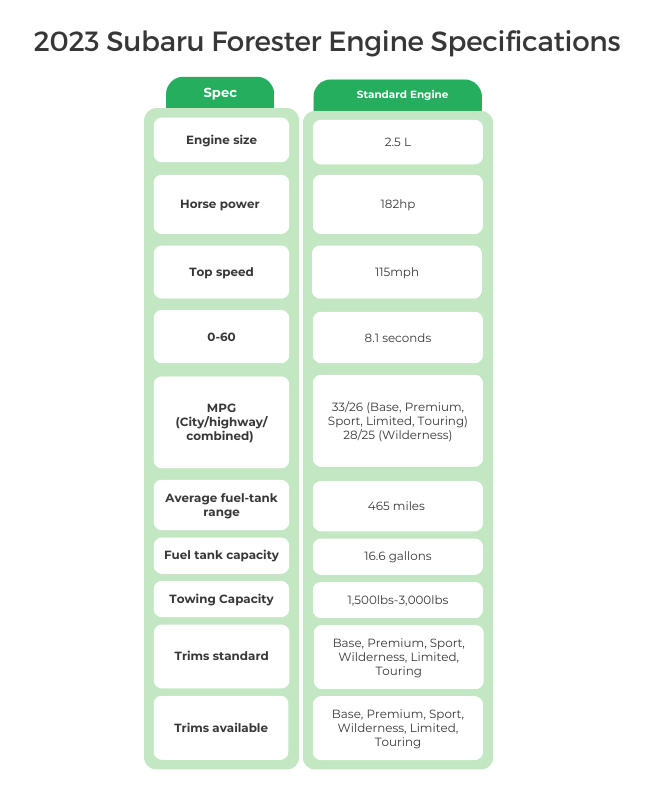
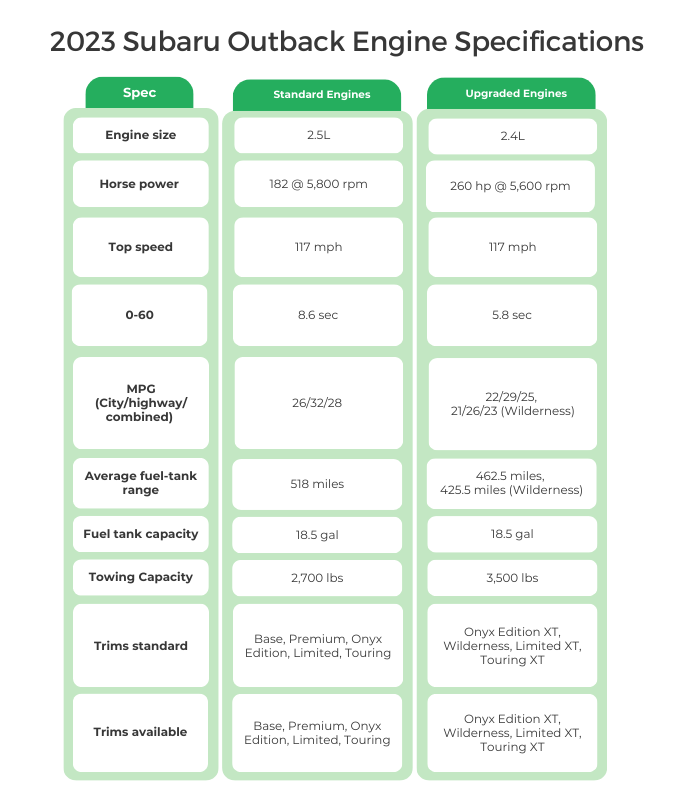
Transmission Options & Specifications:
The Forester versus Outback contest comes out to tie with the transmission. Both vehicles use the same continuously variable transmission (CVT). A CVT is a bit more high-tech than a conventional automatic gearbox and is designed to balance fuel economy and performance. See the “Tech Talk” section below the charts to learn about CVTs.
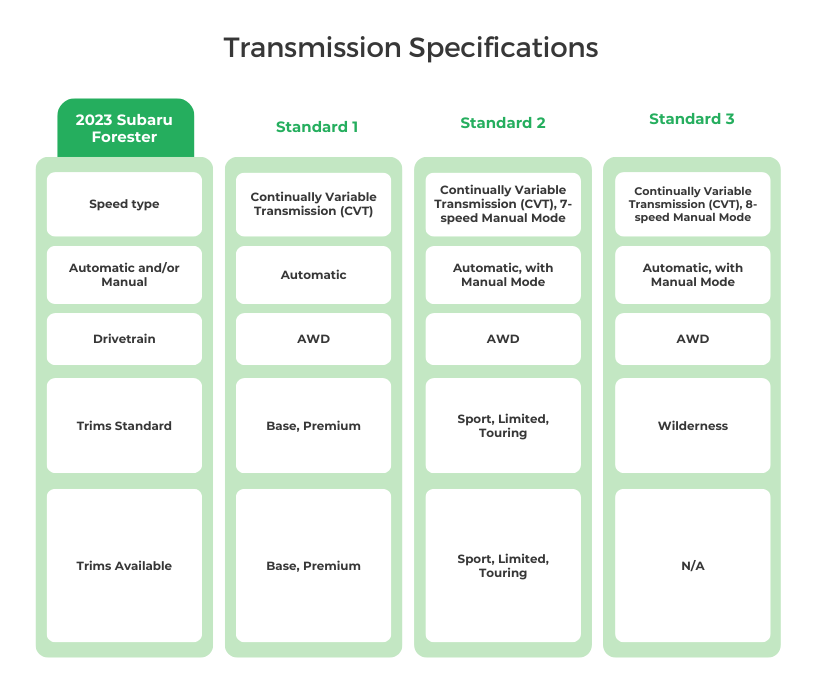
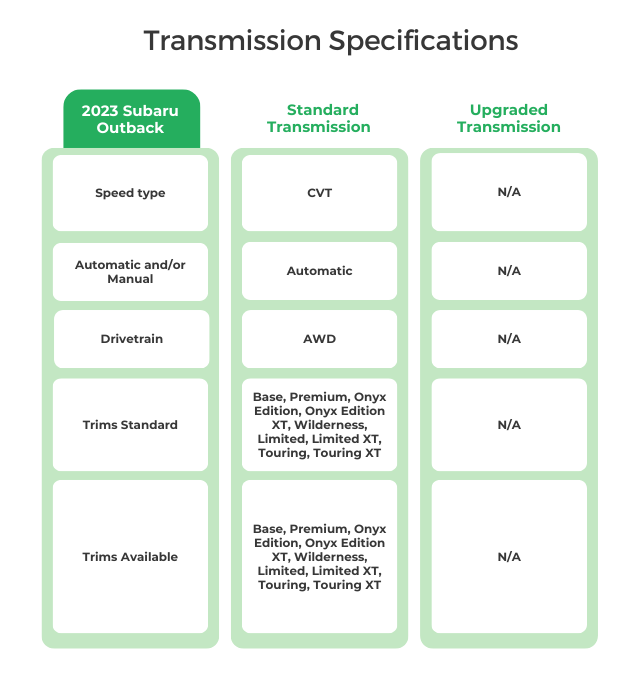
TECH TALK: CVTs
A continuously variable transmission (CVT) does not use gears like a typical automatic transmission. Instead, it has two pulleys connected by a belt. One pulley connects to the engine, and the other connects to the wheels. The belt transfers the power between the pulleys. This setup allows the pulleys to continuously change positions as needed. The CVT automatically adjusts the pulleys as required, providing smooth and efficient power delivery.
Drivetrain:
One of Subaru’s trademarks is standard all-wheel drive (AWD) on all non-sports car models (the BRZ fastback coupe is rear-wheel drive). So, both the Forester and Outback are strictly AWD. This drivetrain comparison is another tie.
|
2023 Subaru Forester Wheel Drive |
FWD |
AWD |
RWD |
|
Base |
S |
||
|
Premium |
S |
||
|
Sport |
S |
||
|
Wilderness |
S |
||
|
Limited |
S |
||
|
Touring |
S |
|
2023 Subaru Outback Wheel Drive |
FWD |
AWD |
RWD |
|
Base |
S |
||
|
Premium |
S |
||
|
Onyx Edition |
S |
||
|
Onyx Edition XT |
S |
||
|
Wilderness |
S |
||
|
Limited |
S |
||
|
Limited XT |
S |
||
|
Touring |
S |
||
|
Touring XT |
S |
S = Standard
Safety:
NHTSA Safety Ratings
Subaru makes a point of playing up safety in its marketing, rivaling Volvo for hammering this message. It’s an effort that makes perfect sense, given that FIXD surveys show Forester and Outback owners use their cars more for family transportation than anything else (44% for Forester, 43% for Outback).
These Subarus also spend a lot of time on the road for commuting and long-distance driving duties (31% for Forester and 26% for Outback), activities we categorize as “lots of driving.”
It all emphasizes the importance of solid crash test results, which Subaru delivers. The Forester and Outback received a perfect 5 out of 5 for overall safety in tests conducted by the National Highway Traffic Safety Administration (NHTSA). The same results with frontal and side crash tests reinforce these noteworthy achievements. It doesn’t get any better than this.
If there’s any shortfall, both vehicles score a 4 in NHTSA’s rollover evaluation. However, this is a typical result for elevated cars like SUVs and pickups.
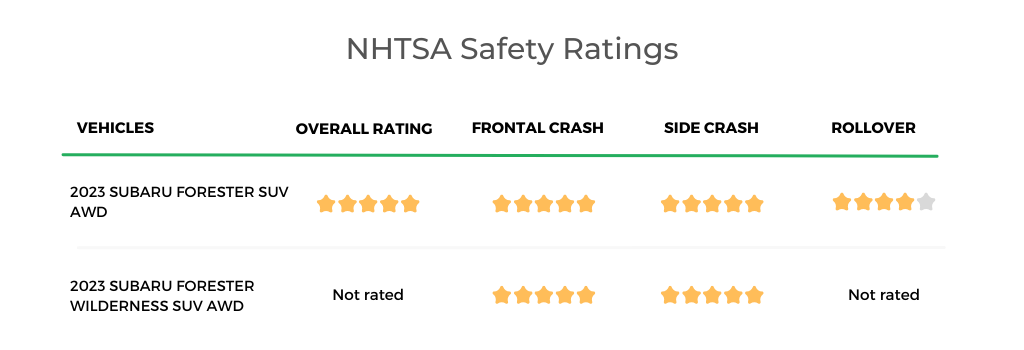
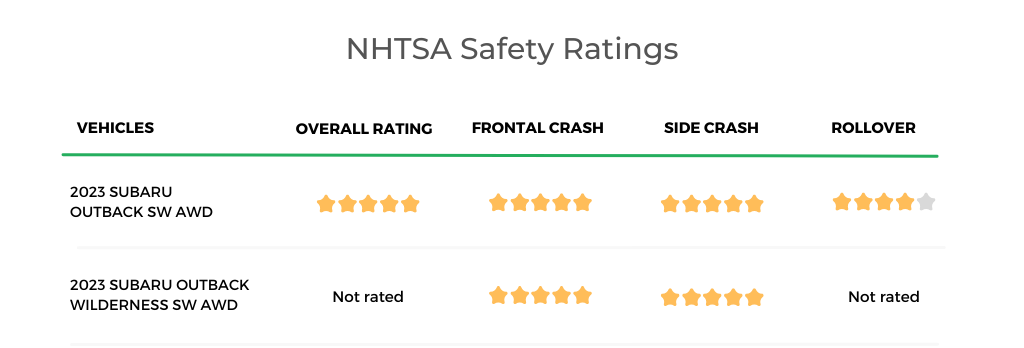
IIHS Awards:
The Insurance Institute for Highway Safety (IIHS) takes a somewhat different approach to safety testing. In particular, it focuses on its small frontal overlap crash test, which the organization feels represents a more real-world scenario (a single car running into a fixed object). IIHS also looks at side impact crashes, roof strength, headlight effectiveness, and advanced driver safety technologies (like automatic emergency braking).
While tested vehicles receive a Good, Acceptable, Marginal, or Poor grade, the true measure comes if a car gets a Top Safety Pick or Top Safety Pick+ designation. If “Good” is a “B” grade, Top Safety Pick notches things up to an “A-,” and the Top Safety Pick+ signifies an “A+.”
There’s certainly nothing wrong with the 2023 Forester receiving a Top Safety Pick. However, the 2023 Outback’s Top Safety Pick+ designation gives it a slight leg up.
|
IIHS Award |
Tested Vehicles |
||
|
2023 Subaru Forester |
2023 TOP SAFETY PICK |
2019 Subaru Forester Premium 4WD |
|
|
2021 Subaru Forester 4WD |
|||
|
2023 Subaru Outback |
2023 TOP SAFETY PICK + |
2020 Subaru Legacy Premium 4WD |
|
|
2022 Subaru Outback Premium 4WD |
|||
|
2023 Subaru Outback 4WD |
|||
Airbags & Head Restraints:
Given the Forester’s and Outback’s sameness in so many areas, it’s unsurprising to see both vehicles match up with identical airbag setups. In addition to the typical front and side-impact units for the front row, Subaru includes side curtain airbags that protect both rows in the event of a side-impact collision or rollover. The driver also gets a knee airbag that positions the body to lessen injury in an accident.
Neither the Forester nor the Outback comes with overhead airbags. This newer technology replaces traditional front-row units (steering wheel and dashboard) with overhead devices. Active head restraints are usually found in specialty and high-end vehicles to minimize whiplash injuries. Mainstream cars like the Forester and Outback aren’t usually equipped with this feature.
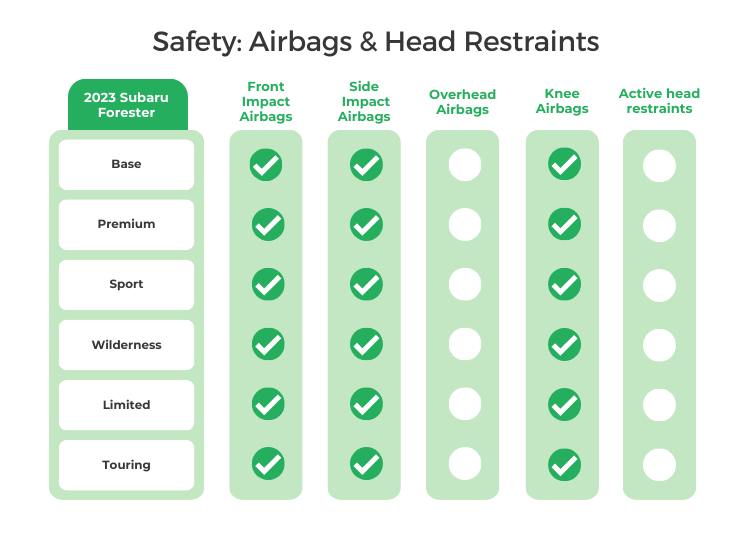

Semi-Autonomous Driving:
Don’t expect cutting-edge technology like hands-free driving in a Subaru; that’s not this automaker’s approach. Instead, Subaru introduces proven systems consistent with its cars’ reputation (deserved or not) as safe and reliable transportation.
That’s why you’ll only find semi-autonomous driving tech like adaptive cruise control (ACC) in the 2023 Forester and Outback. ACC automatically adjusts a car’s speed to maintain a safe distance from vehicles ahead. It reduces the need for constant braking and accelerating in stop-and-go traffic. However, ACC is not autonomous—the driver still needs to steer and remain alert at all times.
Subaru also includes lane keep assist and lane centering to ensure drivers of the 2023 Forester and Outback stay within their lanes. This technology works through an alert system, sensors, and subtle steering corrections (drivers can turn off these features).
Reverse automatic braking (RAB) is another handy safety feature that applies the brakes when reversing if sensors detect an obstacle behind the vehicle. It can warn the driver and auto-brake if needed. This helps avoid backing into objects. RAB is standard on most mid-tier and higher Forester and Outback trims. It’s an option with Forester Sport and Outback Onyx Edition. RAB is unavailable with the base and Premium trims (Forester and Outback).
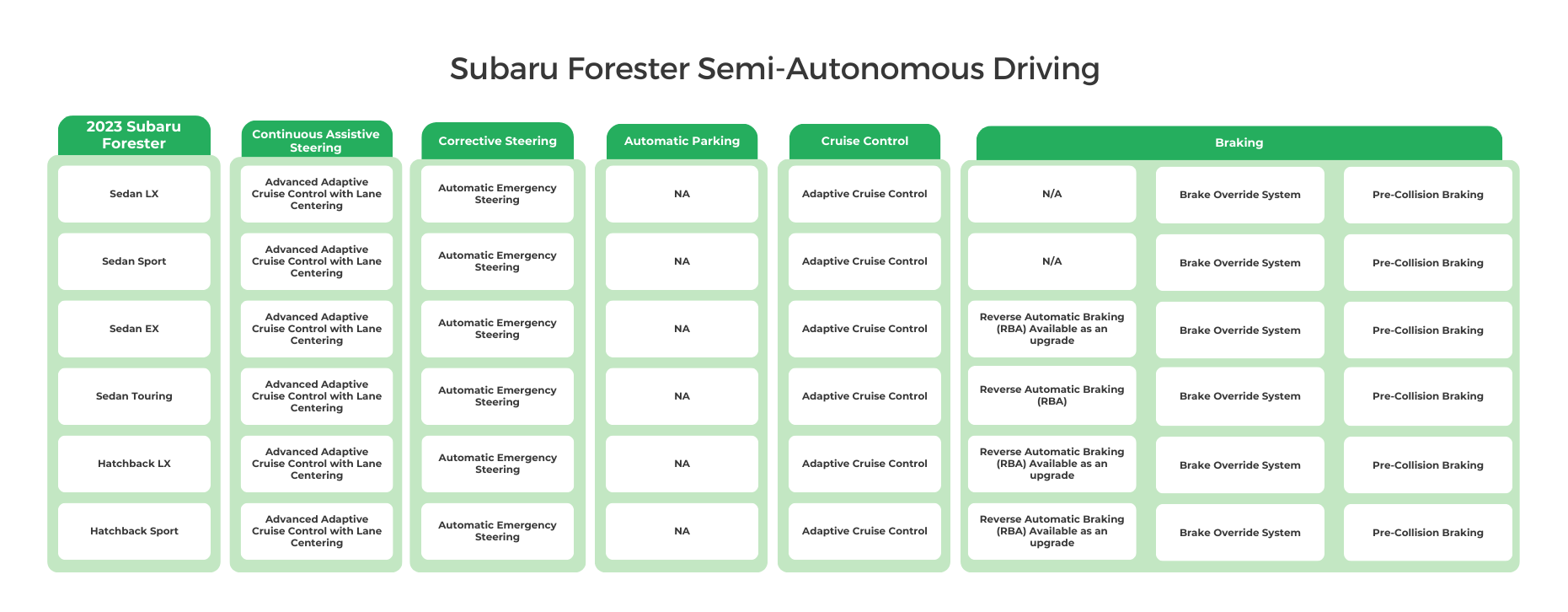
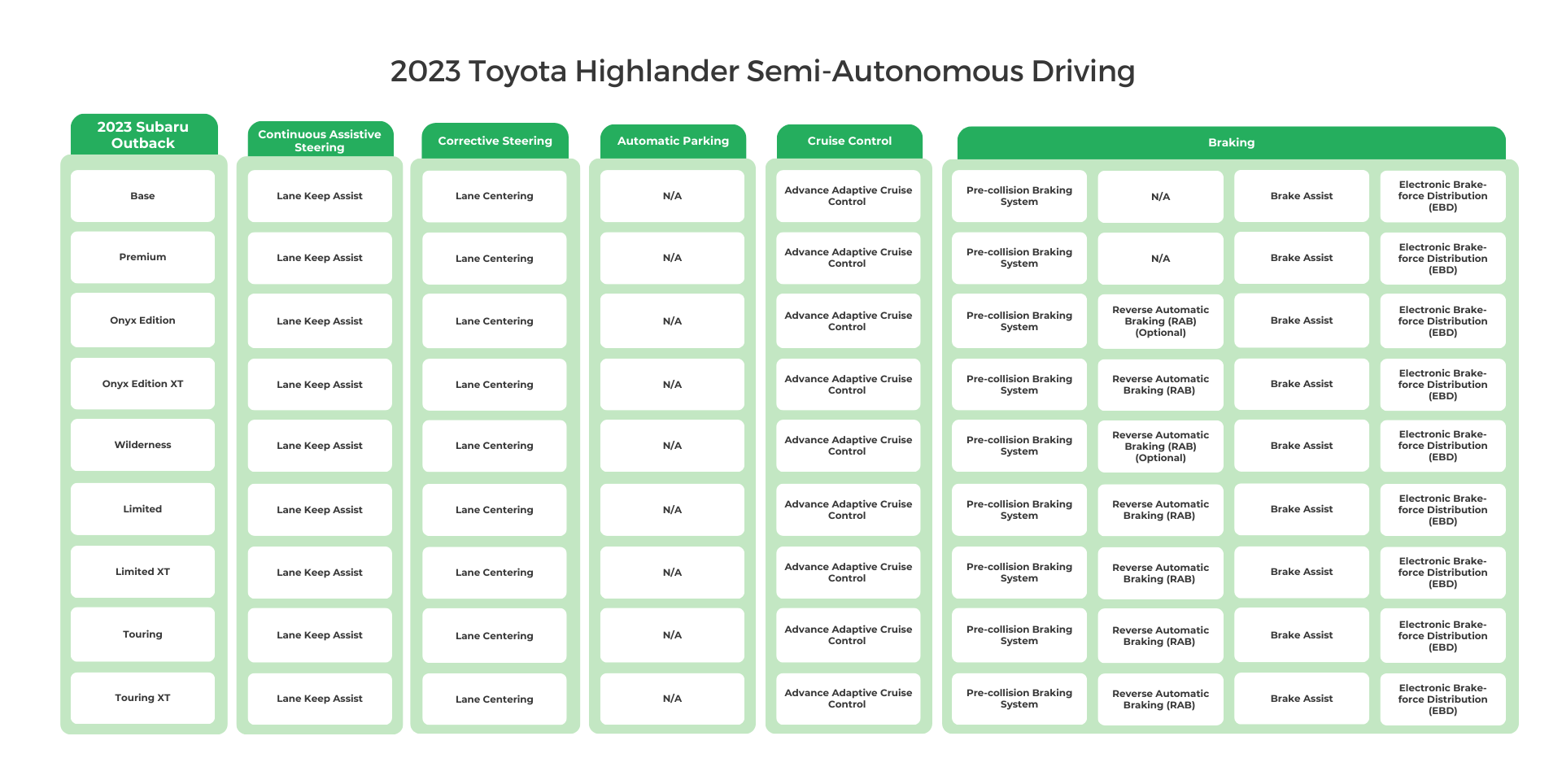
Driver Warning Systems & Telematics:
Packaged under Subaru’s EyeSight label, the 2023 Forester and Outback have numerous standard advanced driver assistance systems (ADAS), technologies designed to minimize or prevent accidents.
At a minimum, all trims get forward collision warning (FCW) and lane departure warning (LDW). FCW alerts a driver if an obstacle is detected ahead, and LDW signals if the driver has steered outside the traffic lane. As part of its pre-collision braking system, automatic emergency braking is included with the Forester and Outback. This technology will automatically apply the brakes if a potential forward collision is identified (pedestrian detection is part of this system).
Other ADAS technology creates a dividing line between the Forester and Outback trims. Blind-spot monitoring (BSM) and rear cross-traffic alert (RCTA) aren’t available on base versions and are optional with the second-from-the-bottom Premium (Forester and Outback). However, all higher trims get BSM and RCTA as standard equipment.
Both cars (all trims) come with a rear seat reminder, so no one gets unintentionally left behind.
If ADAS technology appears like alphabet soup, check out an effort from AAA, Consumer Reports, J.D. Power, and other groups working to standardize the terminology for these systems.

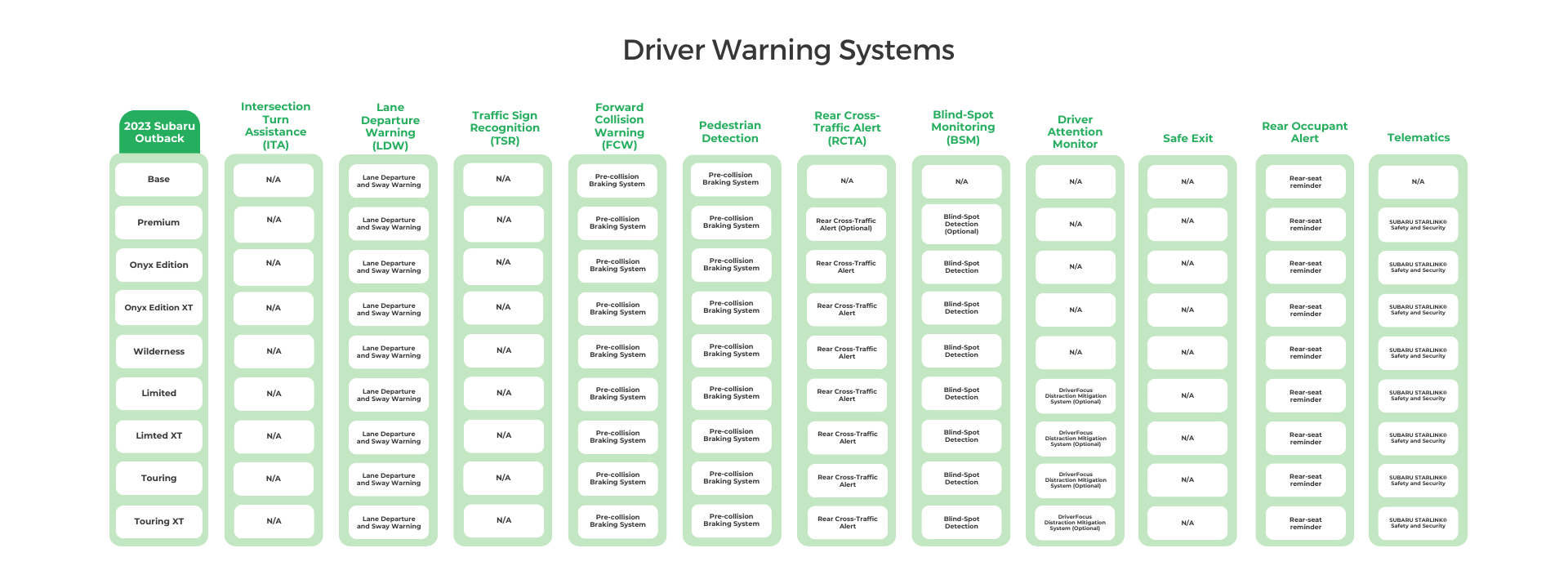
Road Visibility Features:
While base versions of the Forester and Outback don’t have all the safety tech, Subaru gets bonus points for equipping all trims with adaptive headlights. This feature, usually found in more expensive cars, adjusts the direction of the headlights based on steering input to improve visibility when driving at night. Equally as helpful are standard LED headlights and automatic high beams. A rearview camera is included, too, but this is a legal requirement.
Compared to other mainstream SUVs, these Subarus lag somewhat due to a lack of advanced visibility equipment. Not even the top-tier trims have a head-up display (projects critical driving information like vehicle speed directly onto the windshield) or rain-sensing windshield wipers.
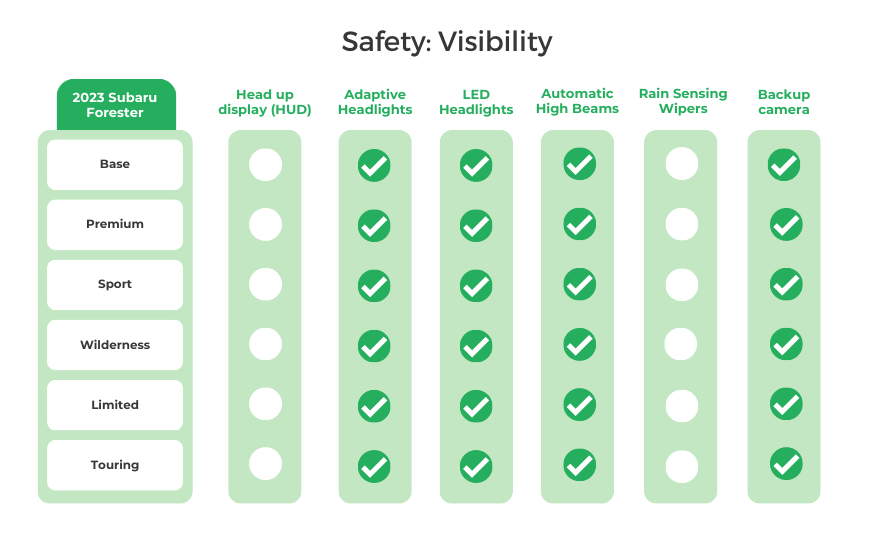

Interior:
Interior Features:
Although the 2023 Forester and Outback may not have every technological bell and whistle, phone-centric shoppers can breathe easier because Apple CarPlay and Android Auto are standard.
Since Subaru is popular in northern states, making heated front seats standard on most Forester and Outback trims makes sense. Only those who buy the base versions are left out in the cold.
And speaking of heated seats, some automakers offer this feature through a subscription service. This hasn’t yet happened in the U.S., but in certain countries, BMW offered heated seats for a monthly fee. The advantage is you can shut off the service during warm months, but you’ll need to keep paying (or pay a one-time upfront fee) to activate the heated seats. Recently, BMW announced it was backing away from this practice. Moving forward, the automaker will only charge a subscription for software-based services (like upgraded navigation). Hardware-based features will be part of the vehicle’s initial purchase price.
One industry study shows mixed results for consumer acceptance of features on demand (FoD), with about one-fifth not even being aware of the concept.

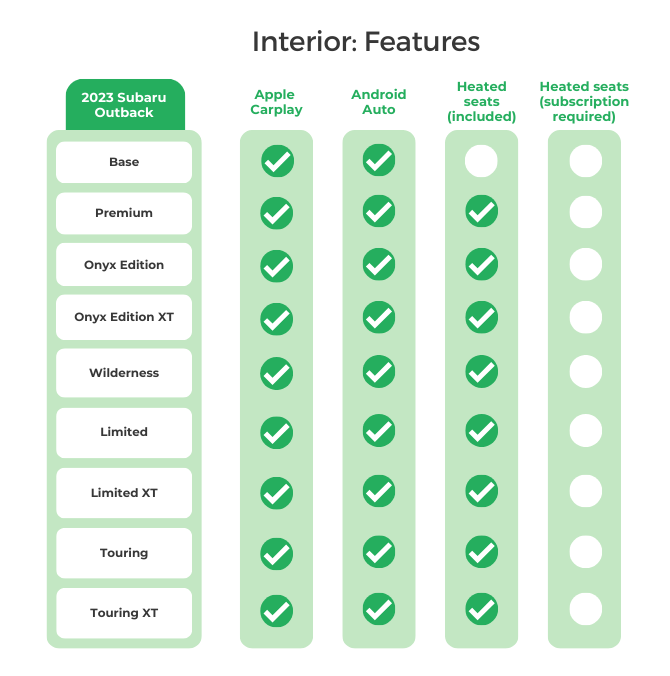
Interior Dimensions:
The modestly larger Outback excels in many interior dimensions, especially cargo space. While most Foresters offer 26.9 cubic feet behind the second row, the Outback has 32.6 cubic feet. This may not seem like much of a difference, but the extra capacity will matter to those who regularly stuff their cars with groceries and gear.
The Outback’s extra bulk also helps with better rear headroom and greater front and rear hip room. Interestingly, the Forester’s 43.3-inch front legroom beats the Outback by half an inch, which could be a selling point for taller front-row occupants.
Otherwise, the interior dimensions for the Forester and Outback are only separated by fractions of inches.
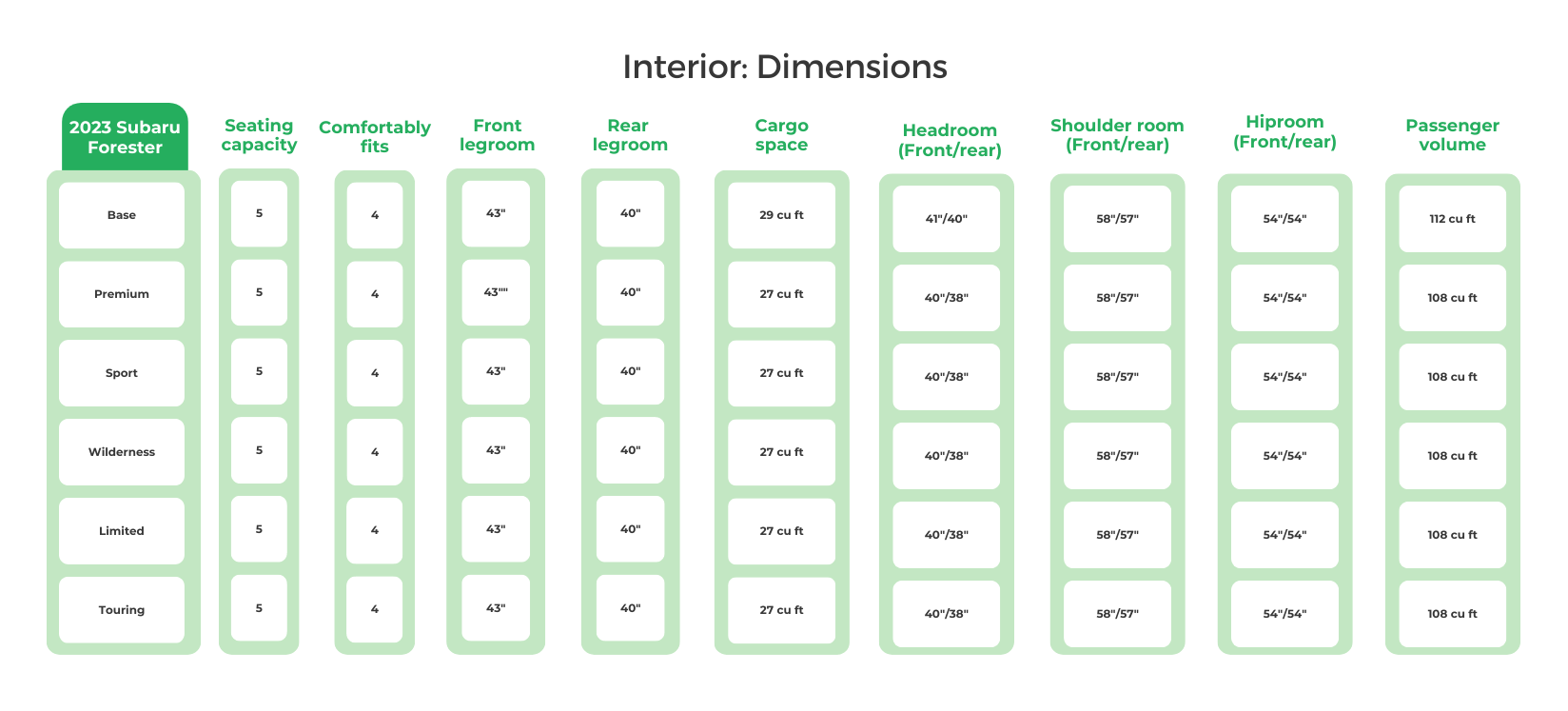
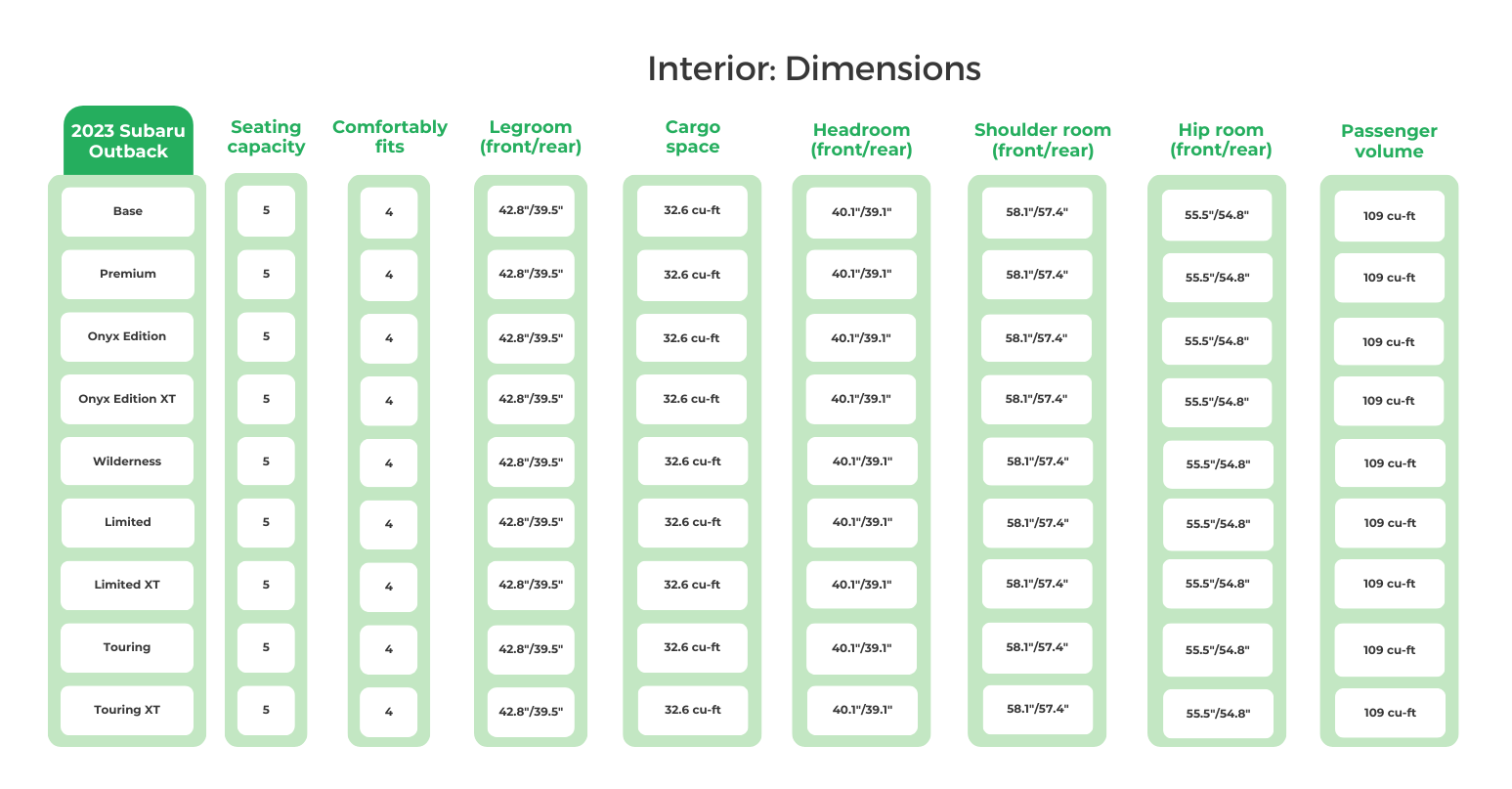
Exterior:
Exterior Features:
Wheels may also be an afterthought for many car buyers. But wheel size can impact ride quality. Larger rims can translate into better traction and cornering but may result in a bumpier ride. Bigger wheels also offer better aesthetics by filling out the wheel wells more completely. This is why the higher the trim, the larger the wheel. Different materials (steel or alloy) and finishes also help separate the wheels among the various trim levels.
Let’s restate the obvious if we haven’t painted a proper picture. The Subaru Forester and Outback are family cars, dashing any hopes for bright colors. Muted reds, blues, greens, and golds don’t exactly spice up the exterior, but at least they’re available in addition to the usual white, black, silver, and gray offerings.
Try the performance-oriented WRX sports sedan if bright colors and a Subaru badge are a must-have.

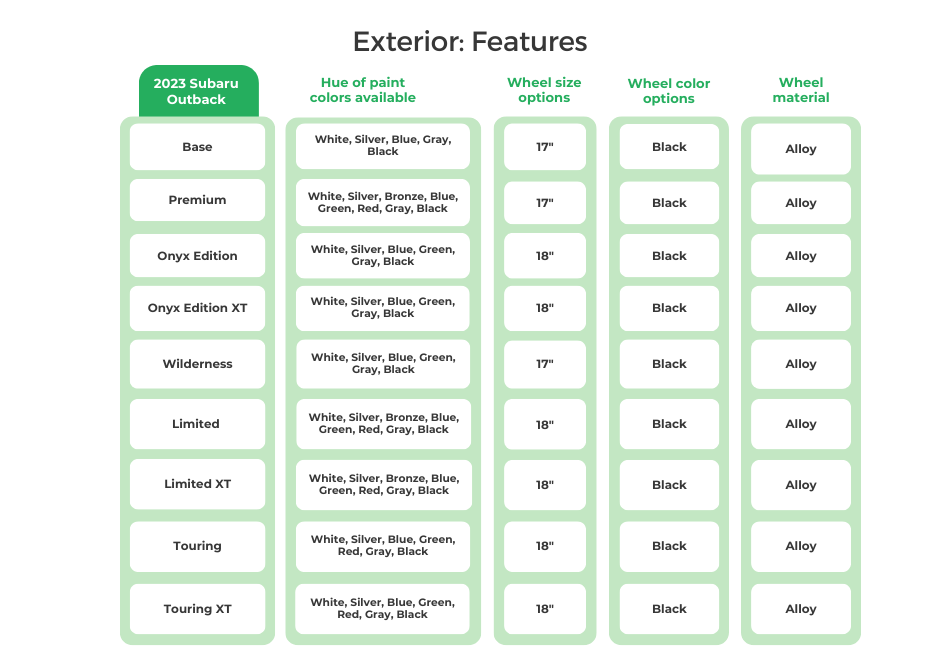
Exterior Dimensions:
Another factor differentiating the Forester and Outback is exterior size. Not only is the Outback 9.2 inches longer, but it’s also 2.7 inches wider. This extra bulk probably isn’t meaningful for most suburban drivers, but a larger exterior can make the Outback more challenging to park in tight spaces. The Forester is two inches taller, which is evident when seeing how its greenhouse compares to the more low-slung Outback.
And except for the Wilderness trims, the Forester and Outback have the same ground clearance (8.7 inches), giving both equal footing when tackling speed bumps and dirt roads. The Forester Wilderness has a 9.2-inch ground clearance, while the Outback Wilderness has a modest advantage with 9.5 inches between the ground and chassis.

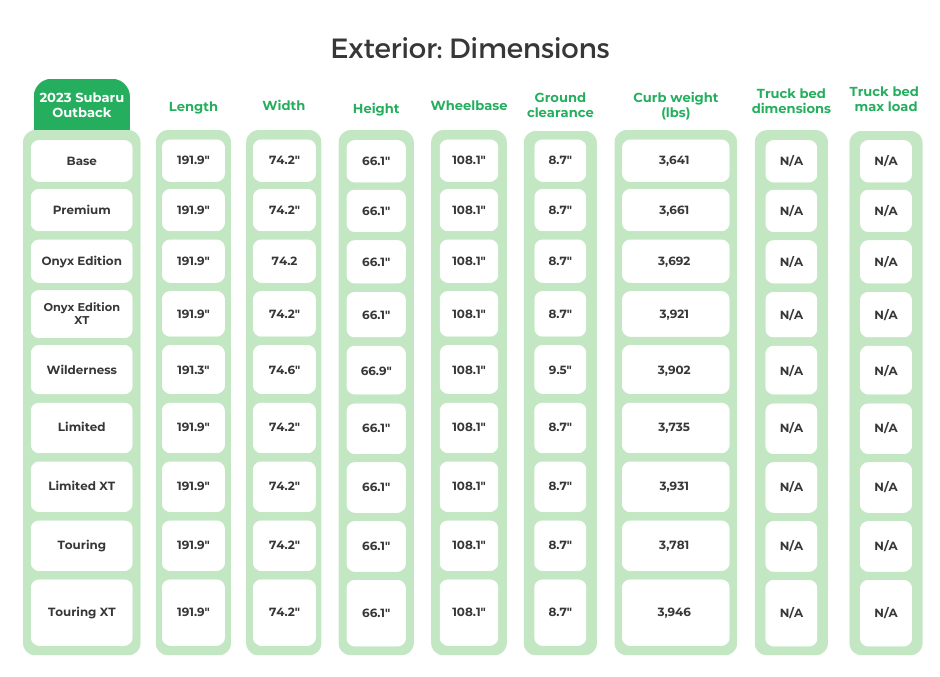
Warranty:
There’s not much to say about Forester and Outback warranty coverage. Both get the same factory warranty from Subaru: three years or 36,000 miles of bumper-to-bumper coverage and powertrain (engine, transmission, and drive axles) protection for five years or 60,000 miles. The bumper-to-bumper warranty also includes roadside assistance.
| 2023 Subaru Forester Factory Warranty Coverage: | 2023 Subaru Outback Factory Warranty Coverage: | |
| Basic warranty: | 36 months/36,000 miles | 36 months/36,000 miles |
| Powertrain warranty: | 60 months/ 60,000 miles | 60 months/ 60,000 miles |
| Corrosion perforation warranty: | 60 months/Unlimited miles | 60 months/Unlimited miles |
| Air conditioning warranty: | 36 months/36,000 miles | 36 months/36,000 miles |
| Battery warranty: | 36 months/36,000 miles | 36 months/36,000 miles |
| Emissions warranty: | 36 months/36,000 miles (Federal), 36 months/50,000 miles (California) | 36 months/36,000 miles (Federal), 36 months/50,000 miles (California) |
| Roadside assistance coverage: | 36 months/36,000 miles | 36 months/36,000 miles |
| Total unique recalls: | 0 | 0 |
Driver Experience | A Summary of The Top 10 Subaru Forester vs. Subaru Outback Reddit Posts:
Owners have a lot to say about their Subaru Foresters and Outbacks, and most of it is favorable. A review of recent Reddit (Reddit: r/whatcarshouldIbuy) comments offered insight into these thoughts.
Strikingly, many commenters heaped praise on their respective Subarus, not realizing that other models had the same features. One Redditor, for instance, touted how well their Forester’s symmetrical all-wheel drive system made it great for “handling various road conditions.” A capability also ingrained in the Outback. The same can be said for the EyeSight driver-assist system.
Yet, other feedback helped clarify how the Forester and Outback stand apart. Several Redditors felt the Outback is better because of its more spacious interior and larger cargo space. Another remarked that Outback’s longer wheelbase provided a smoother and more comfortable ride. But the Forester has its share of champions, with a higher seating position and better visibility among this car’s preferred qualities.
Perhaps one commenter explained how to choose between the two. The Outback is preferable for prioritizing “cargo space and off-road capabilities,” while the Forester is best for those who “want a slightly smaller and more nimble SUV.”
Who Should Buy These Cars: The Legacy of The Subaru Forester and Subaru Outback
As covered earlier, the Forester and Outback are principally used as family haulers, with heavy doses of commuting and long-distance driving mixed in. These are tasks that owners readily take on, especially because these Subarus reach 150,000 miles or more of use, according to FIXD survey data.
We’ve also covered how strong safety scores and decent fuel economy make the Forester and Outback well-suited for these duties, details we’ll explain towards the end of this article.
| Frequent Use Categories: | Subaru Forester | How Useful? (Out of 5 Stars) | Subaru Outback | How Useful? (Out of 5 Stars) |
| Family Vehicle | * * * * * | * * * * * |
| Lots of Driving (travel/long commute) | * * * * | * * * |
| Hauling/Towing | * | * |
| Office on Wheels | * | * |
| Sport/Fast Driving | * | * |
| Luxurious Driving | * | * |
| Outdoor/Off-Road | * | * * |
Best & Worst Years | Subaru Forester vs. Subaru Outback | 2001-2024

A glance at this best and worst years graphic tells us one important thing: not every Forester and Outback model year is perfect. In fact, if you had your heart set on an older Subaru Outback to save money, you might be in for an unpleasant surprise thanks to poor reliability. Our research says not to bother with anything before 2014.
Fortunately, Forester buyers have more options, with the 2002 and 2004 editions offering affordable possibilities. Otherwise, you’ll need to fast forward to at least 2009 while avoiding the 2014 and 2018-2019 model years. Likewise, the Outback has its share of recent misses, which means staying away from the 2015 and 2021 model years.
We’ll call attention to the undecided years (yellow) only because there isn’t enough information to give these editions a thumbs up or down.
Important Features Timeline | Subaru Forester vs. Subaru Outback
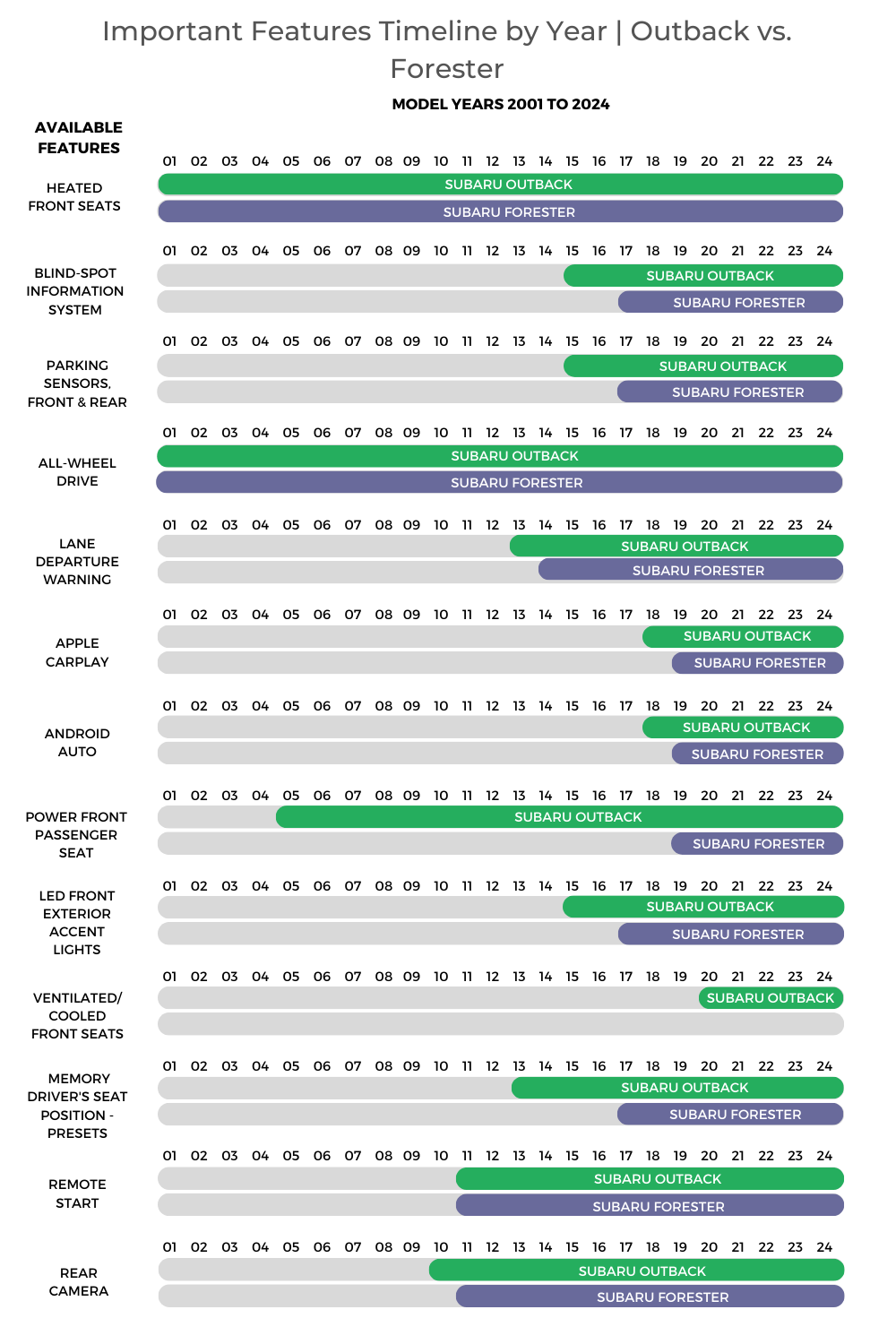
Forester fans shouldn’t be disappointed that the Outback always received a specific feature first. For many years (until the launch of the three-row Ascent), the Outback served as Subaru’s flagship vehicle. It’s only natural for an automaker to bestow the latest goodies based on model pecking order.
Nonetheless, safety equipment like blind-spot monitoring, lane departure warning, and parking sensors made its way to the Forester, as did convenience features like a driver’s memory system, a power front passenger seat, a rearview camera, Apple CarPlay, and Android Auto.
The Outback still claims dibs for ventilated fronts. But it’s only a matter of time before the Forester may offer this upscale feature, which the Toyota RAV4 and other compact crossovers already do.
Maintenance Costs (Year-by-Year Average) | Subaru Forester vs. Subaru Outback
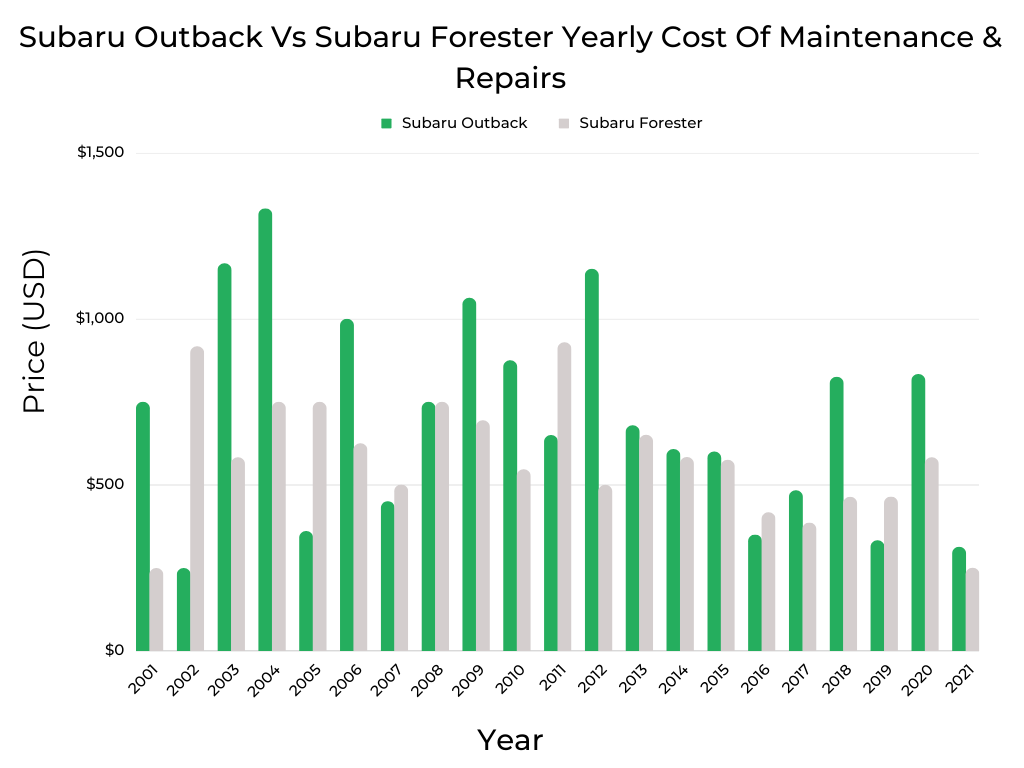
FIXD surveys report that Forester owners spent an average of $579 on maintenance and repairs in 2022. That’s 18% less than the $709 paid by their Outback counterparts.
A further dive into the numbers offers more of a contrast between these two Subarus. In particular, no Forester model year had an average yearly upkeep bill that crossed the $1,000 threshold. Although two editions came close: 2002 at $917 and 2011 at $929. But, this unfortunate benchmark was a frequent achievement for Outback owners. The 2003, 2004, 2006, 2009, and 2012 all came in with maintenance and repairs expenses that topped $1,000.
This leads us to conclude that owning an older Outback is more expensive than an equivalent Forester. Of course, there’s more to low repair bills than luck and build quality. Each owner treats their car differently. Those who practice regular maintenance are more likely to reap the benefits by catching problems early on and helping critical components last longer. However, owners who don’t follow through with regular upkeep will pay for this neglect in the long run.
Review the best and worst years of the Subaru Forester and Subaru Outback to learn more about maintenance and repair costs for these vehicles.
Safety Rating Comparison | Subaru Forester vs. Subaru Outback
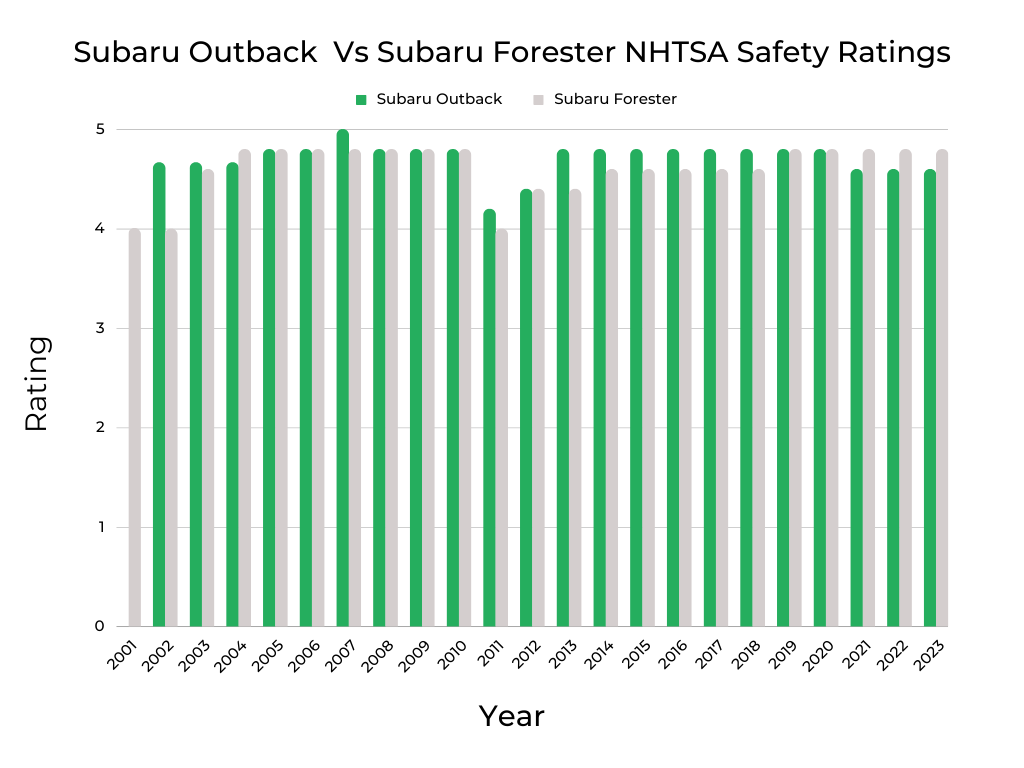
Let’s start our discussion of NHTSA safety testing by saying that any score of 4 or better (out of 5) is notable. That said, no 21st-century Forester or Outback failed to get good grades (NHTSA did not test the 2001 Outback). These results are in keeping with the car’s primary use as family transportation. It’s evident that Subaru takes the “safety sells” methodology to heart.
Short of a few fractions of a point (favoring the Outback or the Forester), both vehicles scored similar results. So, using NHTSA crash tests to pick an Outback over a Forester (or the other way around) is meaningless. Both cars can be considered safe based on government testing.
We’ll point out the dip in testing scores for the 2011 model year when NHTSA mandated more rigorous standards. Many automakers, including Subaru, saw their safety scores take a hit at this time. However, Subaru was able to bring its results up after a year or two.
More details about crash test safety scores are covered in articles about the Subaru Forester and Subaru Outback.
Fuel Efficiency Comparison | Subaru Forester vs. Subaru Outback
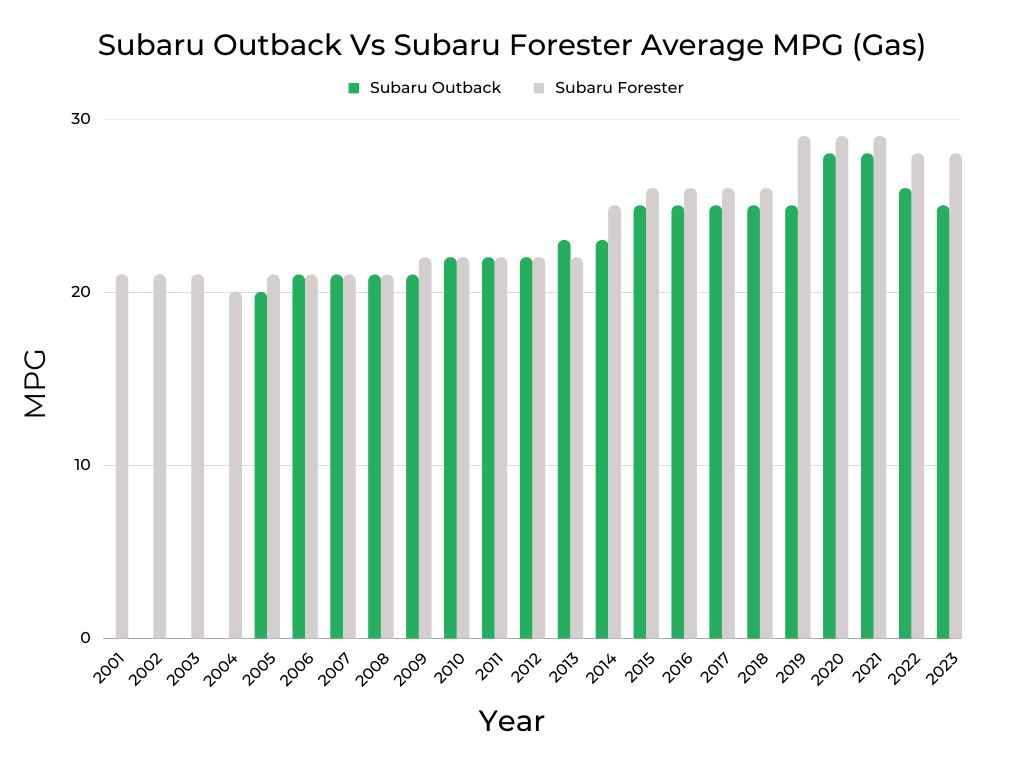
The final battle, fuel economy, between Forester and Outback essentially ends in another tie. As the chart shows, mileage for both these cars is equivalent for each of the comparable model years (MPG info wasn’t available for the 2001-2004 Outback). If you had to pick a winner, you could give the nod to the later years of the Forester, as the Outback got bigger (and heavier) and engineers squeezed more efficiency out of the Forester.
Methodology
- Compare two vehicles, Subaru Forester vs Subaru Outback, and provide a comprehensive analysis.
- Gather relevant information and data on both vehicles from reliable sources, such as manufacturer specifications, expert reviews, customer feedback, industry reports, and data sources like manufacturer websites, FIXD App, Kelley Blue Book, FuelEconomy.gov, and NHTSA.
- Collect data on various aspects, including performance, safety features, fuel efficiency, maintenance costs, reliability, owner satisfaction, and market value.
- Identify the key criteria that will be used to evaluate and compare the two vehicles.
- Ensure the criteria cover both objective factors (such as performance metrics, safety ratings, and fuel efficiency) and subjective factors (such as owner satisfaction, comfort, and features).
- Assess the performance of both vehicles based on factors such as acceleration, handling, braking, and overall driving experience.
- Compare engine options, horsepower, torque, transmission options, and any unique performance features.
- Examine the safety features and ratings of both vehicles.
- Evaluate crash test ratings, advanced driver assistance systems (ADAS), active and passive safety features, and any notable recalls or known issues related to safety.
- Consider both NHTSA safety ratings and IIHS awards for a comprehensive safety assessment.
- Analyze the fuel economy of both vehicles based on EPA mileage estimates.
- Compare their MPG ratings, average full-tank range, and any significant differences in fuel efficiency.
- Assess the average annual maintenance and repair costs for both vehicles.
- Consider data from surveyed owners and other reliable sources, such as FIXD App owner surveys, to determine the overall cost of ownership over time.
- Evaluate the reliability of both vehicles based on owner reports, FIXD App data, and any known issues or recalls.
- Consider factors such as engine reliability, common problems by model year, long-term durability, and owner reliability scores gathered from surveys.
- Consider owner satisfaction by gathering information from forums, online communities (Reddit: r/whatcarshouldIbuy), customer reviews, and owner reliability scores.
- Summarize key factors that owners appreciate and any common complaints or drawbacks mentioned by owners.
- Compare the features and technologies offered by both vehicles.
- Highlight any notable differences in terms of infotainment systems, connectivity options, driver assistance features, interior quality, and available upgrades.
- Assess the market value and depreciation of both vehicles.
- Compare average prices, resale value, and how the vehicles hold their value over time.
- Consider average private-seller valuations from Kelley Blue Book (KBB) for a comprehensive assessment.
- Summarize the findings of the comparison, highlighting the positives and negatives of each vehicle.
- Provide a fair and balanced recommendation based on the comparison, considering factors such as budget, personal preferences, specific needs of the buyer, and the comprehensive analysis conducted.
Sources:
-
- KBB Values: Average private-seller valuations as supplied by Kelley Blue Book (KBB), based on a Chevrolet Equinox with typical mileage for that respective model year.
- Fuel Economy: Mileage-per-gallon estimates according to the EPA MPG on Fueleconomy.gov.
- Annual Maintenance/Repairs: Upkeep expenses as reported by surveyed Chevrolet Equinox owners.
- Safety Ratings: Crash test data collected and reported by NHTSA. We average all ratings for each year to come up with a simplified, average safety score. This makes it easier to look at on a graph. We also collected IIHS Awards for this article.
- Vehicle Features: Most or all information gathered on vehicle features was from the manufacturer’s website, in this case, Subaru.com.

Dave Goldberg is an automotive journalist and lifelong car fanatic. He writes for numerous enthusiast and business outlets and is an ongoing contributor to HotCars.com, one of the most popular car culture websites. When he’s not writing or driving, Dave is either under a hood or asleep. His credentials include a BA in Journalism from The George Washington University.

